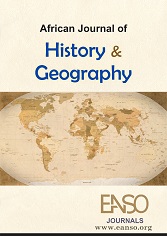The Role of Children Mau Mau Movement. A Case of Nyandarua County, between 1945 -1957
Abstract
After the establishment of colonial rule, colonial land, labour, racial and other exploitative policies forced the Africans to take arms against colonial oppression. This led to the Mau Mau war of liberation. The purpose of this study was to investigate the role of children in the Mau Mau movement in Nyandarua County between 1945 to 1963. This paper examines how Mau Mau Mau's oath was administered to children and the role played by children. The paper further analyses the challenges and sufferings experienced by the children in the Mau Mau movement. On the oathing, most of the informants who confessed to having undergone the oath ritual indicated that the exercise happened before the declaration of the state of emergency and were tricked into the oathing scene by people close to them - cousins, friends, and sometimes parents. The role of children in the Mau Mau movement included: One, spying and supplying intelligence to the Mau Mau forest fighters. They were charged with the responsibility of spying on the movements of the home guards and then infiltrating the same intelligence to the fighters who acted on the same. The same boys were used as messengers. As fast winners, they were hired to audaciously run combat intelligence from one location to another. Due to their innocence, this was perfectly done as both colonial and home guards never suspected them. Two, they were employed to furnish the forest fighters with food and other errands. Girls who had undertaken the Mau Mau oath took this task with precision and exhibited excellent skills that helped them disguise the colonial guards. Three, girls solicited information and firearms from unsuspecting colonial guards and home guards. Firearms were a necessity for the Africans whenever they were to launch successive expeditions against the imperialists. The young boys and girls did a commendable job in furnishing the fighters with this vital necessity. Four, young boys and girls did join the fighters in the forest.
Downloads
References
Anderson, D. (2005). Histories of the Hanged: The Dirty War in Kenya. London: W.W. Norton and Company.
Bennett, H. (2012). Fighting the Mau Mau: The British Army and Counter insurgency in the Kenya Emergency. London: Cambridge University Press.
Chege, R. (2015). Lake Naivasha the Maasai and the British in the making of the Naivasha town. Journal of International Academic Research International Academic Research, Vol 3, No 1.
Elkins, C. (2005). Imperial Reckoning: The Untold Story of the British’s Gulag. London: Henry Holt.
Emerton, LL., (1999). “Mount Kenya: The Economics of Community Conservation,” Evaluating Eden Series, Discussion Paper No.4.
Furedi, F. (1989). The Mau Mau war in Perspective. Ohio: Ohio University Press.
Gacheri, J. Daily Nation. 6th June 2014.
Hughes, L. (2006). Moving the Maasai: A colonial misadventure. London: Palgrave Macmillan.
Itote, W. (1979). Mau Mau in Action. Nairobi: Trans-African press.
Kanogo, T. (1987). Squatters and the Roots of Mau Mau. Ohio: Ohio University pressPress.
Kantai, P. (2007). “In the Grip of the Vampire State: Maasai land struggles Land Struggles in Kenyan Politics”, Journal of Eastern African Studies, vol. 1, No. 1.
Karani, R. (2005). Field Marshall Muthoni: Mau Mau Heroine. Nairobi: Sasa Sema Publication.
Kinyatti, M. (2008). History of Resistance in Kenya (1884-2002). Nairobi: Mau Mau research center.
Kimamira, J. K., Muchoki, F., & Moindi, K. (2024). Impact of Mau Mau Movement on The Family Unit: A Case Study of Nyandarua County From 1952 to 1963. African Journal of History and Geography, 3(1), 10-26.
KNA/PC/NKU/3/8/1/ Labour, Employment of the native
Leakey, L. (1954). Defeating Mau Mau. London: Methuen& Co.
Logle, L. and Dyson, W. (1962) Forestry in Kenya: A Historical Account of the development of forest management in the colony. Nairobi: Government printer
Majdalany, F. (1962). State of Emergency: The Full Story of Mau Mau. London: Green and Co.
Mwangi, E. “Colonialism, Self-Governance and Forestry in Kenya: Policy, Practice and Outcomes,”http://dlc.dlib.indiana.edu/dlc/bitstream/handle/10535/5706/Colonialism%20self%20governanc%20and%20forestry%20in%20Kenya.pdf?sequence=1, (retrieved on 21/02/2016).
Nottinham, J and Rosberg, C. (1970). The Myth of Mau Mau: Nationalism in Kenya. New York: Meridian books.
Otieno, W. (1998). Mau Mau’s Daughters. London: Lynne Rienner publishers
Copyright (c) 2025 Joseph Kanagi Kimamira, Francis Macharia Muchoki, PhD, Kennedyokaya Moindi, PhD

This work is licensed under a Creative Commons Attribution 4.0 International License.




























